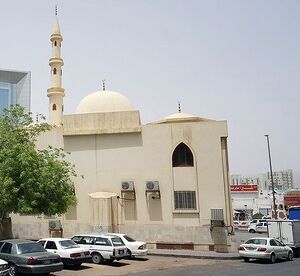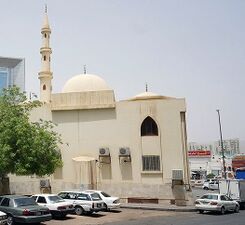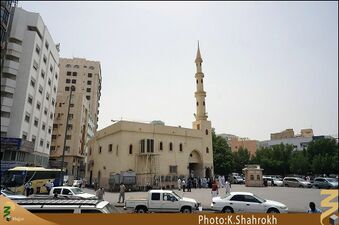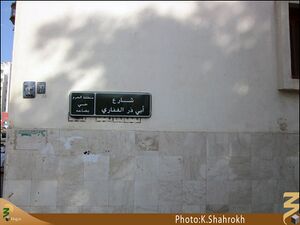Al-Sajda Mosque: Difference between revisions
Pourghorbani (talk | contribs) No edit summary |
No edit summary |
||
| (13 intermediate revisions by 2 users not shown) | |||
| Line 1: | Line 1: | ||
'''Sajda Mosque''' is one of the old mosques in [[Medina]], which was built in the prayer place of the [[Prophet | {{Building | ||
| title = Al-Sajda Mosque | |||
| image = مسجد ابوذر غفاری۵.jpg | |||
| image size = | |||
| image link = | |||
| image description = | |||
| other names = Abu Dharr Mosque, Al-Buhayri Mosque, Al-ʾAswaf Mosque, Al-Safila Mosque | |||
| place = [[Madina]] 900 meters north of [[al-Masjid al-Nabawi]] | |||
| usage = Mosque | |||
| religious affiliation = | |||
| beliefs = | |||
| rituals = | |||
| rulings = | |||
| pilgrims = | |||
| visitors = | |||
| time of construction = | |||
| founder = | |||
| events = | |||
| reconstructions = | |||
| reconstructors = | |||
| missing parts = | |||
| historical features = | |||
| trustee = | |||
| space = | |||
| length = | |||
| width = | |||
| height = | |||
| status = Active | |||
| capacity = | |||
| facilities = | |||
| parts = | |||
| architect = | |||
| style = | |||
| properties = | |||
| domes = | |||
| minarets = | |||
| doors = | |||
| porticos = | |||
| courts = | |||
| verandas = | |||
| affiliated entity = | |||
| maintaining entity = | |||
| administrator = | |||
| imam of prayer = | |||
| subsidiary entities = | |||
| registered in = | |||
| registration no. = | |||
| registration date = | |||
| website = | |||
| latitude = 24.4756388882977 | |||
| longitude = 39.61461066158393 | |||
| map description = | |||
}} | |||
'''Al-Sajda Mosque''' (Arabic: {{ia|مسجد السجدة}}) is one of the old mosques in [[Medina]], which was built in the prayer place of the [[Prophet Muhammad(a)]]. The mosque is located in the north of [[al-Masjid al-Nabawi]] at the intersection of Abu Dharr Street and Airport Street. This mosque is also known as al-Buhayri Mosque, Abu Dharr Mosque and 'Aswaf Mosque. | |||
== | ==Location== | ||
This mosque is located 900 meters north of [[al-Masjid al-Nabawi]] at the intersection of Abu Dharr Street and Airport Street.<ref>ʿAbd al-Ghanī, ''al-Masājid al-atharīyya'', p. 93.</ref> | |||
== | ==Story== | ||
This mosque has been called by different names. | [[Prophet Muhammad(a)]] prayed in this place. The last sajda of the Prophet(a) was so long that the companions thought that he had passed away. When he got up from sajda, he said: [[Gabriel]] came to me and said: Whoever from your nation sends blessings upon you, God sends blessings upon him; I performed sajda for gratitude.<ref>Samhūdī, ''Wafāʾ al-wafā'', vol. 3, p. 209-210.</ref> | ||
It is not exactly clear why and when this mosque became known as | |||
==Names== | |||
This mosque has been called by different names. It is called the al-Sajda or al-Shukr (gratitude) because of the sajda of the Prophet mentioned above. Because it was next to the garden of al-Buhayri, it was called al-Buhayr or al-Buhayri Mosque, and because it was close to the Aswaf palm grove or on the way to al-Safila Gardens, it was also called al-Aswaf or al-Safila Mosque.<ref>ʿAbd al-Ghanī, ''al-Masājid al-atharīyya'', p. 92-93.</ref> | |||
It is not exactly clear why and when this mosque became known as Abu Dharr Mosque, but al-Matari, a [[local historian of Medina]], mentioned it as Abu Dharr Mosque in the 8th/14th century. Al-Samhudi doubted the correctness of this naming, but the name of Abu Dharr Mosque has been widely used.<ref>Najafī, ''Madīna shināsī'', p. 206-207; ʿAbd al-Ghanī, ''al-Masājid al-atharīyya'', p. 93.</ref> | |||
==History of the mosque== | ==History of the mosque== | ||
Al-Matari (d. 741/1340-41) writes in the book of [[Al-Ta'rif bi-ma ansat al-hijra]] that on al-Safila Road, which is the eastern road to [[Hamza's grave]], there is a very small mosque, which is called Abu Dharr Mosque.<ref>Maṭarī, ''al-Taʿrīf bi-mā ansat al-hijra'', p. 147-148.</ref> At the end of the 9th/15th century, al-Samhudi (d. 911/1505-6) described the mosque as a small building with dimensions of 8 cubits by 8 cubits located near a palm grove called al-Buhayr.<ref>Samhūdī, ''Wafāʾ al-wafā'', vol. 3, p. 209.</ref> | |||
Another report from the year 1303/1885-6 | |||
Sayyid | Another report from the year 1303/1885-6 describes the place as a small mosque without a roof near al-Sadaqa spring.<ref>ʿAbd al-Ghanī, ''al-Masājid al-atharīyya'', p. 95.</ref> 'Abd al-Quddus al-Ansari, also spoke about this mosque in his book. He described al-Buhayr Mosque as a very small square mosque with a length and width of 4 meters and according to his report, the walls of this mosque were one meter high.<ref>Anṣārī, ''Āthār al-Madīna al-munawwara'', p. 139-140.</ref> | ||
Sayyid Ahmad Yasin al-Khayari, in his book, which was first published in 1410/1989-90, spoke about the reconstruction of the mosque where this mosque was under the supervision of the Department of Awqaf of Saudi Arabia.<ref>Khayārī, ''Tārīkh maʿālim al-Madīna al-munawwara'', p. 180.</ref> In his book, Ilyas 'Abd al-Ghani also considered the reconstructed mosque to be 18 meters long and 10.13 meters wide.<ref>ʿAbd al-Ghanī, ''al-Masājid al-atharīyya'', p. 94.</ref> | |||
==Gallery== | ==Gallery== | ||
<gallery mode="packed" heights="150px"> | <gallery mode="packed" heights="150px"> | ||
| Line 22: | Line 80: | ||
file:مسجد ابوذر غفاری۱.jpg | file:مسجد ابوذر غفاری۱.jpg | ||
</gallery> | </gallery> | ||
Notes== | ==Notes== | ||
{{Notes}} | {{Notes}} | ||
== | |||
{{References} | ==References== | ||
* | {{References}} | ||
*Anṣārī, | * ʿAbd al-Ghanī, Muḥammad Ilyās. ''Al-Masājid al-atharīyya fī l- Madīna al-munawwara''. Medina: [n.p], 2000. | ||
*Khayārī, Sayyid Aḥmad Yāsīn al-.''Tārīkh | * Anṣārī, ʿAbd al-Quddūs al-. ''Āthār al-Madīna al-munawwara''. Medina: Maktabat al-Salafīyya, 1973. | ||
*Maṭarī, Muḥammad b. Aḥmad al-. ''Al-Taʿrīf | * Khayārī, Sayyid Aḥmad Yāsīn al-.''Tārīkh maʿālim al-Madīna al-munawwara qadīman wa ḥadīthan''. Riyadh: al-Amāna al-ʿāmma li-l-Iḥtifāl Miʾat ʿĀm ʿAlā l-Taʾsīs al-Mamlaka al-ʿArabīyya al-Suʿūdīyya, 1419/1999. | ||
*Najafī, Sayyid | * Maṭarī, Muḥammad b. Aḥmad al-. ''Al-Taʿrīf bi-mā ansat al-hijra min maʿālim dār al-hijra''. Riyadh: Dār al-Malik ʿAbd al-ʿAzīz, 2005. | ||
* | * Najafī, Sayyid Muhammad Bāqir. ''Madīna shināsī''. Tehran: Mashʿar, 1387Sh. | ||
* Samhūdī, ʿAlī b. ʿAbd Allāh. ''Wafāʾ al-wafā bi-akhbār dar al-Muṣṭafā''. Beirut: 1984. | |||
{{end}} | {{end}} | ||
[[fa:مسجد سجده]] | [[fa:مسجد سجده]] | ||
[[category:Medina]] | |||
Latest revision as of 17:35, 13 December 2023
 | |
| General Information | |
|---|---|
| Other Names | Abu Dharr Mosque, Al-Buhayri Mosque, Al-ʾAswaf Mosque, Al-Safila Mosque |
| Place | Madina 900 meters north of al-Masjid al-Nabawi |
| Usage | Mosque |
| Current State | |
| Status | Active |
Al-Sajda Mosque (Arabic: مسجد السجدة) is one of the old mosques in Medina, which was built in the prayer place of the Prophet Muhammad(a). The mosque is located in the north of al-Masjid al-Nabawi at the intersection of Abu Dharr Street and Airport Street. This mosque is also known as al-Buhayri Mosque, Abu Dharr Mosque and 'Aswaf Mosque.
Location
This mosque is located 900 meters north of al-Masjid al-Nabawi at the intersection of Abu Dharr Street and Airport Street.[1]
Story
Prophet Muhammad(a) prayed in this place. The last sajda of the Prophet(a) was so long that the companions thought that he had passed away. When he got up from sajda, he said: Gabriel came to me and said: Whoever from your nation sends blessings upon you, God sends blessings upon him; I performed sajda for gratitude.[2]
Names
This mosque has been called by different names. It is called the al-Sajda or al-Shukr (gratitude) because of the sajda of the Prophet mentioned above. Because it was next to the garden of al-Buhayri, it was called al-Buhayr or al-Buhayri Mosque, and because it was close to the Aswaf palm grove or on the way to al-Safila Gardens, it was also called al-Aswaf or al-Safila Mosque.[3]
It is not exactly clear why and when this mosque became known as Abu Dharr Mosque, but al-Matari, a local historian of Medina, mentioned it as Abu Dharr Mosque in the 8th/14th century. Al-Samhudi doubted the correctness of this naming, but the name of Abu Dharr Mosque has been widely used.[4]
History of the mosque
Al-Matari (d. 741/1340-41) writes in the book of Al-Ta'rif bi-ma ansat al-hijra that on al-Safila Road, which is the eastern road to Hamza's grave, there is a very small mosque, which is called Abu Dharr Mosque.[5] At the end of the 9th/15th century, al-Samhudi (d. 911/1505-6) described the mosque as a small building with dimensions of 8 cubits by 8 cubits located near a palm grove called al-Buhayr.[6]
Another report from the year 1303/1885-6 describes the place as a small mosque without a roof near al-Sadaqa spring.[7] 'Abd al-Quddus al-Ansari, also spoke about this mosque in his book. He described al-Buhayr Mosque as a very small square mosque with a length and width of 4 meters and according to his report, the walls of this mosque were one meter high.[8]
Sayyid Ahmad Yasin al-Khayari, in his book, which was first published in 1410/1989-90, spoke about the reconstruction of the mosque where this mosque was under the supervision of the Department of Awqaf of Saudi Arabia.[9] In his book, Ilyas 'Abd al-Ghani also considered the reconstructed mosque to be 18 meters long and 10.13 meters wide.[10]
Gallery
Notes
- ↑ ʿAbd al-Ghanī, al-Masājid al-atharīyya, p. 93.
- ↑ Samhūdī, Wafāʾ al-wafā, vol. 3, p. 209-210.
- ↑ ʿAbd al-Ghanī, al-Masājid al-atharīyya, p. 92-93.
- ↑ Najafī, Madīna shināsī, p. 206-207; ʿAbd al-Ghanī, al-Masājid al-atharīyya, p. 93.
- ↑ Maṭarī, al-Taʿrīf bi-mā ansat al-hijra, p. 147-148.
- ↑ Samhūdī, Wafāʾ al-wafā, vol. 3, p. 209.
- ↑ ʿAbd al-Ghanī, al-Masājid al-atharīyya, p. 95.
- ↑ Anṣārī, Āthār al-Madīna al-munawwara, p. 139-140.
- ↑ Khayārī, Tārīkh maʿālim al-Madīna al-munawwara, p. 180.
- ↑ ʿAbd al-Ghanī, al-Masājid al-atharīyya, p. 94.
References
- ʿAbd al-Ghanī, Muḥammad Ilyās. Al-Masājid al-atharīyya fī l- Madīna al-munawwara. Medina: [n.p], 2000.
- Anṣārī, ʿAbd al-Quddūs al-. Āthār al-Madīna al-munawwara. Medina: Maktabat al-Salafīyya, 1973.
- Khayārī, Sayyid Aḥmad Yāsīn al-.Tārīkh maʿālim al-Madīna al-munawwara qadīman wa ḥadīthan. Riyadh: al-Amāna al-ʿāmma li-l-Iḥtifāl Miʾat ʿĀm ʿAlā l-Taʾsīs al-Mamlaka al-ʿArabīyya al-Suʿūdīyya, 1419/1999.
- Maṭarī, Muḥammad b. Aḥmad al-. Al-Taʿrīf bi-mā ansat al-hijra min maʿālim dār al-hijra. Riyadh: Dār al-Malik ʿAbd al-ʿAzīz, 2005.
- Najafī, Sayyid Muhammad Bāqir. Madīna shināsī. Tehran: Mashʿar, 1387Sh.
- Samhūdī, ʿAlī b. ʿAbd Allāh. Wafāʾ al-wafā bi-akhbār dar al-Muṣṭafā. Beirut: 1984.




